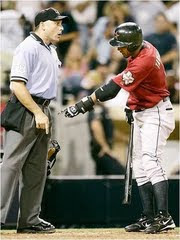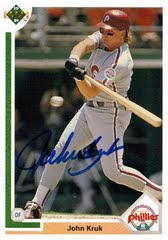
The major league average payroll as a percentage of revenue has fluctuated between 45% and 54% over the past six years. Only once (2005), did the Marlins surpass the league average payroll/revenue mark. In fact, in 2006, the Marlins' payroll as a percentage of revenue was 1/4th that of the league average -- a pathetic 12.6%.
Some may make the argument that Florida is a small market team with limited resources and a great scouting department which can afford to squeeze pennies left and right. There is some credence to this argument -- that is, to the extent that the Marlins' GM, Michael Hill, has a great eye for talent. However, unlike other small market teams who spend well under the league average payroll/revenue rate (ie, the Pittsburgh Pirates), the Marlins are in a key position to contend -- not for the NL East, of course, but for the Wild Card. In terms of WAR, the Marlins were a top four NL team with respect to offense last season (+19.6 WAR). And despite the fact that their combined pitching value of +14.1 WAR ranked bottom half of the league last season, they were within 5 WAR of a top 4 spot in pitching (a gap that could be bridged with a Matt Holliday-like player (a +5.7 or higher WAR player each of the last three seasons, including his injured 2008)). Collectively, the Marlins were a +33.7 WAR team last season. That made them the sixth best NL team, behind the Dodgers (+43.3 WAR), Rockies (+42.3 WAR), Braves (+41.3 WAR), Phillies (+40.8 WAR), and Cardinals (+38.1 WAR). Next season, it looks the Cardinals will lose Joel Pinero (+4.8 WAR) and perhaps even Matt Holliday (+2.7 WAR for the Cardinals) and the Rockies will lose the value that Jason Marquis (+3.8 WAR) provided them. With a smart FA addition (specifically Holliday and perhaps a Valverde-like player), the Marlins stand in a good position to be a top four NL team next season with the right additions. As Fangraphs pointed out earlier this month, "the composition of a team’s talent and their relation to their division opponents can have a pretty significant effect on their internal marginal value of a win. A win to the Rays is significantly more valuable than a win to the Astros because of the respective effect of that win on the odds of either team making the playoffs."
In other words, the Marlins are exactly the kind of team that should be spending some money on the Free Agency market. And yet, according to Nick Cafardo's latest piece "there’s no doubt the Marlins are planning another payroll dump and Uggla would appear to be at the center of it."
Yes, Uggla is about to get a little pricey (MLBTradeRumors thinks Uggla will get a raise somewhere in the $7 million range), but he is still a +3 WAR (or more, as Uggla's 2007 and 2009 BABIPs were well below his xBABIPs) player, making him worth $13+ million in terms of free agency expenditure to replace his contributions to the team. Rather than pinching the pennies, shipping Uggla out, and relying on Bonafacio (.303 OBP, -0.4 WAR last season) and Chris Coghlan (a quality player, +2.3 WAR in limited playing time last season) to fill the hole that Uggla's departure would leave, the Marlins should instead keep Uggla, use Coghlan as well, and collectively signing both Matt Holliday and Valverde for $20-22 million, finding ways to saving some salary elsewhere (such as non-tendering Cantu) and improving the team without dismantling the farm system or disassembling a quality 25-man roster. Especially since it's essentially a crap-shoot as to who wins the World Series once the playoffs begin (at least according to BP's book Baseball Between The Numbers).
However, in the words of Cafardo, "the Marlins, who receive a ton in revenue-sharing and central-fund money, are looking to keep their profit margin high." It's a sad, sad situation. Loria is committed to pocketing every dollar and forcing others to pay his expenses. Something needs to be done about the Marlins situation before Loria ruins an already limited (in terms of revenue, not profit) franchise. They have the money to spend and they are in a situation where they really should spend it.
________
EDIT: I think Dan Szymborski said it best in his 2010 ZiPS projection for the Marlins: "The Marlins continuing to win 85-90 games relies on Beinfest and Hill continuing to spin straw into gold faster than Jeff Loria can give it away, which is a very difficult task."







3 comments:
yr post is getting buried whether you want it or not.
i like how your valverde-like player became valverde later in the psot
look who's talking
Me: see that girl in the wheelchair?
You: yeah, did you put her there?
You: Does she bowl?
Me: I dont know
You: Whats her handicap?
how many wins would a zero WAR team get in a season?
never mind i just looked it up myself. i guess the old baseball saying that you win 60, lose 60, and the other 42 are up for grabs is wrong as well.
the 2003 tigers were actually 6 wins below replacement level. and their manager is now the cubs bench coach. awesome
Post a Comment